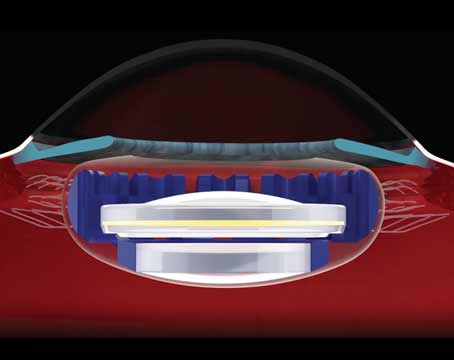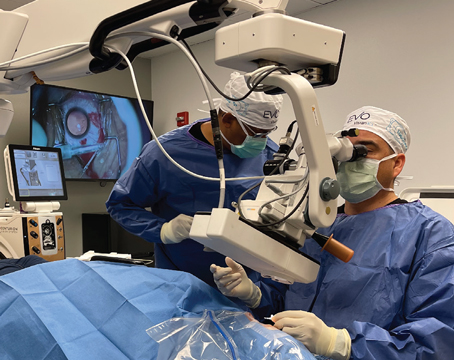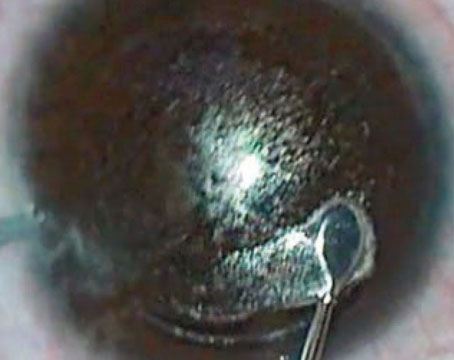The femtosecond laser may have finally gotten over the hump in terms of surgeon acceptance, at least according to this year's survey of surgeons from the International Society of Refractive Surgery. For the first time since the femtosecond arrived on the scene, more ISRS surgeons say they use a femtosecond for their flaps than a blade microkeratome, report the survey's administrators,
Technology Trends
Though opinions on procedures and techniques are the main focus of the survey, there were interesting trends in how surgeons use technology, as well.
The percentage of surgeons who say they use the Visx laser for most of their cases is 58 percent on this year's survey, a decrease of 9 percentage points compared to last year. The percentage of WaveLight Allegretto users, however, has increased from 18 percent to 29 percent. "I think that's significant," says Dr. Duffey. "WaveLight's increase is coincident with a reduction in Visx users on the survey. Visx dropped below 60 percent for the first time in the history of the survey, but it still has a 2:1 lead right now. It will be interesting to see where that will go and what Visx will do to try to hold its position. Right now, however, I think everyone is just treading water and waiting for the economy to improve. However, I don't think these numbers are just a one-time thing, but instead are a trend."
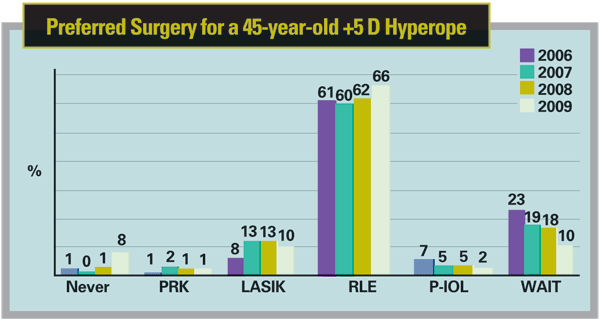
In another first for the survey, the femtosecond laser, as represented by the IntraLase and Ziemer devices, is the flap-making modality preferred by most of the surgeons (46 percent for the IntraLase and 6 percent for the Ziemer). The option preferred by the second largest group of surgeons, the Bausch & Lomb Hansatome, which was preferred by 55 percent of surgeons four years ago, is now the primary option for only 13 percent of them. Dr. Duffey says you can also look at these numbers in another way. "The other thing to remember is that, when you're looking at the femtosecond market, on this survey it's surgeons that prefer it," he says. "That doesn't take into account procedure volume.
There's no doubt that, early on in the femtosecond's life, when it was preferred by 20 percent of surgeons, those surgeons represented probably twice that percentage in terms of the total procedures being done because the femtosecond was in the hands of the high-volume surgeons. These surgeons tended to gravitate toward the femtosecond earlier, probably because they had the higher volume to support the added cost. So now, when you see that 52 percent of the surgeons say they prefer it, I'm sure that IntraLase would say they have an even higher market share in terms of cases done. I haven't seen those numbers this year to corroborate that, but that would be my suspicion."
Surgical Volumes
According to the responses from study participants, their refractive surgery volume is down about 15 percentage points. Dr. Duffey says this may be a positive sign. "I was surprised it was only down by 15 points," he says. "I don't know where all other surgical entities are in terms of volume, but when I talk with colleagues, it seems that a reduction of 15 percent is a pretty soft number." Dr. Duffey was under the impression that practices are down much more than that. "However, the only thing I have to compare the number with is the data set from last year," he says. "I was a little encouraged that maybe we're not as far down as I would have thought."
Surgical Issues
In last year's survey, surgeons were evenly divided over whether they'd perform refractive surgery on a one-eyed patient. This year, however, 59 percent of respondents say they wouldn't. "I thought this was interesting," says Dr. Duffey. "I used to do such surgery without thinking twice, but I stopped about five years ago. Essentially, if a one-eyed patient wants refractive surgery, I won't do it. I think surgeons have grown more cautious. We're more concerned about ectasia and have a lower threshold as to when we won't do a case. You're seeing that also in the increase in the volume of PRK relative to LASIK. I think surgeons are constantly trying to make sure that they follow 'First, do no harm.' "
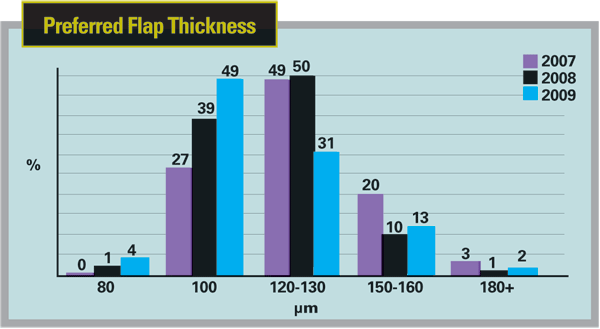
Another interesting turn of events saw the percentage of surgeons who say they'd perform bilateral, simultaneous refractive lens exchange double from 4 to 8 percent. Also, 18 percent say they'd do bilateral, simultaneous phakic intraocular lens implantation. Dr. Duffey wonders about the bilateral RLE responses, however. "I don't believe that many people are doing it," he avers. "I think that statistic is the people who are saying that it's acceptable. The reason is because I've talked with people who answered affirmatively, but when I ask them what convinced them, the response I get back is, 'Well, I don't really do it that way yet, but I want to do it.' So, when you're into really low percentages, such as less than 10 percent, I start to take it with a grain of salt. However, I think you're starting to see, particularly with phakic IOLs, surgeons may be more inclined to do bilateral phakic lens implants at the same sitting."
Refractive lens exchange for the hyperope has grown significantly over the past several years. In 2005, 11 percent of surgeons said they'd use it for a +3 D patient. Now, 19 percent say they'd prefer it. The percentage is even higher for a +5 D hyperope, with two-thirds of surgeons preferring it; that's an increase over the 55 percent of surgeons in 2005 who said it was their primary option. Dr. Duffey says this number jibes with his experience. "I use myself as sort of a gauge," he says. "The +3 D hyperope on whom I would have done PRK or LASIK five years ago now gets a refractive lens exchange. This is because these patients tend to be over 50, which means you have something of a moving target due to their lens changes. The last thing I want to do is perform laser vision correction on a 55-year-old hyperope who's +3, only to have him show up in my exam lane five years later saying, 'I spent a lot of money on refractive surgery, why am I now back in glasses?' The reason is that as their lens changes, the index of refraction of the lens changes and they become more myopic, hyperopic or sometimes even astigmatic. So, if you're really looking for long-term stability, I think surgeons are realizing that the 55+ age group does better with a lens procedure than it does with a laser procedure."
